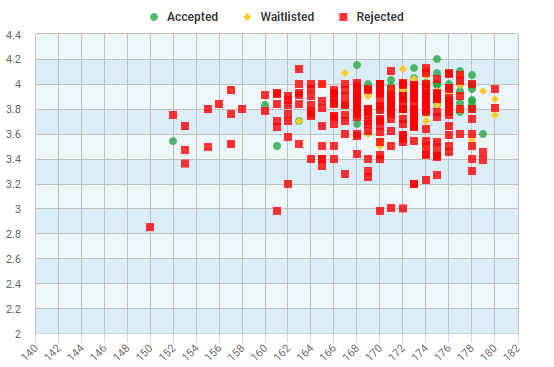Wake Forest Law School
General Info

Founded in 1894, Wake Forest School of Law is a nationally recognized academic community of 470 students and 40 teacher-scholars. Small by design, its programs produce astute and confident lawyers broadly educated in the skills, traditions, and ethics of practice. It offer three degree programs: the JD, the JD/MBA, and the LLM in American Law.
Contact information
- (Website) https://www.law.wfu.edu/
- (Admissions Dean) lawadmissions@wfu.edu
- (Location) Winston-Salem, NC
Wake Forest Law School Admissions
Wake Forest Law School is considered a Somewhat Competitive law school, which accepts only 56% of its applicants. Comparatively, Wake is Higher than the average cost for law school.
| Applications | Offers | Matriculated | |
|---|---|---|---|
| Class of 2029 | 1989 | 1106 (55.61%) | 140 (7.0%) |
| 25% | Median | 75% | |
| GPA | 3.35 | 3.60 | 3.72 |
| LSAT | 157 | 161 | 162 |
Tuition And Financial Aid
| In-State Resident | Non-Resident | |
|---|---|---|
| Full Time | $42,738 | N/A |
| Part Time | N/A | N/A |
Living Expenses
- Living on-campus: N/A
- Living off-campus: $20,772
- Living at home: N/A
Important Dates
- Early Decision 1: N/A
- Early Decision 2: N/A
- Regular Decision: N/A
- Application Fee: $75
Wake Forest Law School Admissions Predictor Tool
Wake Forest Law School COMPARISON TOOL
Wake Forest Law School


Wake Forest Law School Community
Wake Forest Law School is considered to have a Favorable student to faculty ratio. The average class size for 1L sections is approximately Above Average compared to other law schools. Student diversity at Wake is Below Average.
Student body
Faculty Statistics
- Full Time: 41
- Part Time: 21
Faculty
- # Female Faculty: 33
- # Minority Faculty: 7
Ratio
12.3 Students
1 Faculty
Housing Options
- On Campus Housing: No
- Graduate Housing: No
- Law Specific Housing: No
Wake Forest Law School Curriculum
The size of 1L sections affects the quality and consistency of teaching in law schools. Generally with smaller 1L section sizes, students receive more individualized attention. Wake Forest Law School 1L section size is 7% larger than law schools in North Carolina and 1% larger than all PRIVATE law schools.
1L Section Size Comparison
Positions Available in Advanced Courses
- Simulation Courses: 473
- Faculty Supervised Clinics: 205
Students Involved in Advanced Activities
- Field Placements: 107
- Law Journals: 172
- Moot Court/Mock Trials: 0
Attrition Rates
- First Year: 3.4%
- Second Year: 0.5%
- Third Year: 0.0%
- Fourth Year: 0.0%
Wake Forest Law School Employment
Deciding to attend law school requires a large financial investment with the goal of securing employment upon graduation. The Wake Forest Law School class of 2024 had an employment rate of 91% with 2% pursuing an additional degree.
Employment Comparison
In 2024, 78.7%% of students reported their employment status 9-months after graduation.
Type of Employment
- Law Firms: 47.0%
- Business: 20.0%
- Government: 13.0%
- Public Interest: 6.0%
- Academia: 4.0%
- North Carolina: 48%
- District of Columbia: 6%
- Maryland: 5%
Bar Passage Rates
- Reporting: 78.7%
- First Time Takers: 197
- Average School: 82.0%
- Average State: 71.8%
- Pass Difference: 10.2%
Top Bar Jurisdiction
- North Carolina: 69.1%
- Passed: 78 of 100 (78.0%)
- State Average: 71.8%
- Difference: 8.9%
